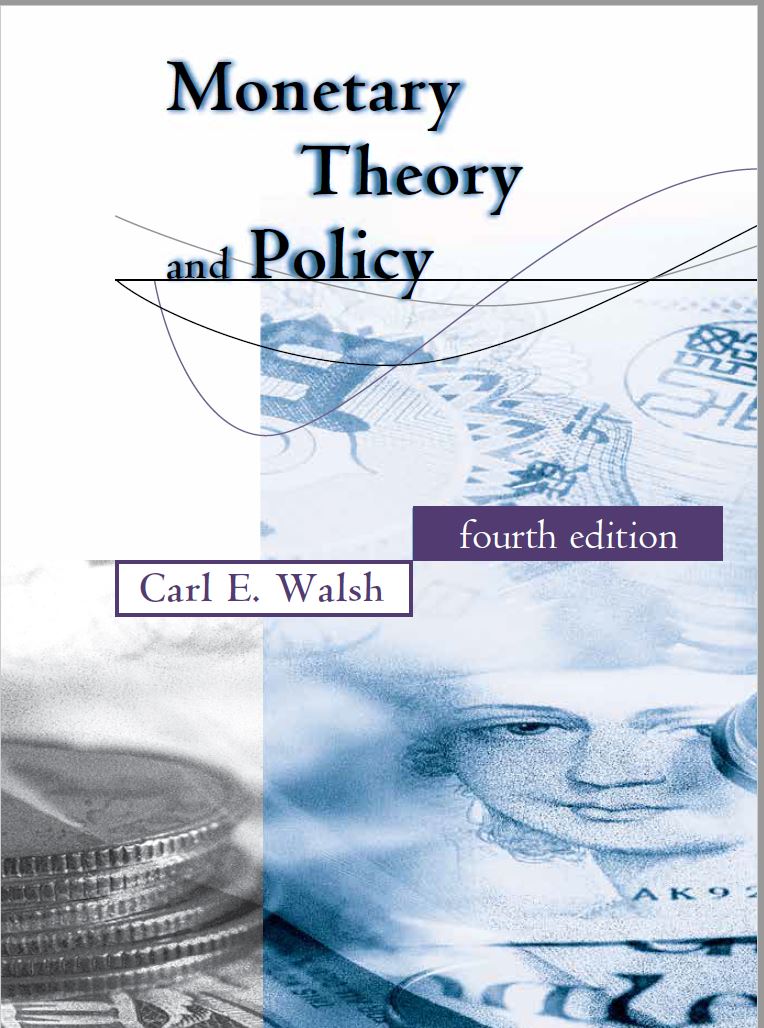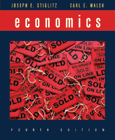Monetary Policy and
Labor Market Frictions: a Tax Interpretation, with Federico Ravenna, Journal of Monetary Economics), March 2012, 59(2): 180-195.
Appendix (Previously titled The Welfare Consequences of Monetary Policy and
the Role of the Labor Market: a Tax Interpretation). Now available at Science Direct.
Welfare-based optimal monetary policy with unemployment and sticky prices: A linear-quadratic framework
with Federico Ravenna. AEJ Macroeconomics, April 2011, 3(2):130-162. Appendix.
Vacancies, Unemployment, and the Phillips Curve, (with Federico Ravenna), European Economic Review 52 (2008), 1494-1521 (published version)
Labor Market Search, Sticky Prices, and Interest Rate Policies, Review of Economic Dynamics 8(2005), 829-849.
Labor Market Search and Monetary Shocks, Aug. 2002.
in Elements of Dynamic Macroeconomic Analysis, S. Altug, J. Chadha, and C. Nolan, editors,
Cambridge University Press, 2003, 451-486. JEL: E52, E58. Appendix to Labor Market Search and Monetary Shocks.
Monetary policy and other topics:
The role of money in monetary policy at the lower bound, joint with Roberto Billi and Ulf Soderstrom, Journal of Money, Credit and Banking June 2023, 55(4): 691-716.
(earlier versions: Sveriges Riksbank Working Paper Series No. 390, CEPR Discussion Paper 14865, June 2020). Abstract: In light of the current low-interest-rate environment, we reconsider the merits of strict money
growth targeting (MGT) relative to conventional inflation targeting (IT) and to price level targeting (PLT). We evaluate these policies in terms of social welfare through the lens of a New Keynesian model and accounting for a zero lower bound (ZLB) constraint on the nominal interest
rate. Although MGT makes monetary policy vulnerable to money demand shocks, MGT contributes to achieving price level stationarity and significantly reduces the incidence and severity
of the ZLB relative to both IT and PLT. Furthermore, MGT lessens the need for fiscal expansions to supplement monetary policy in fighting recessions.
Is super active fiscal policy desirable?, joint with Roberto Billi. SUERF Policy Brief No. 323, April 2022.
Alternatives to inflation targeting in low interest rate environments, Monetary and Economic Studies, 2019, 37: 41-69.
Keynote at the 2019 Conference of the Bank of Japan's Institute for Monetary and Economics Studies, Tokyo May 2019. Abstract: The challenges of a low interest rate, low inflation environment have led to calls to
re-examine the basic framework of flexible inflation targeting (IT). Interest in alternatives such as price-level targeting (PLT) and average inflation targeting (AIT)
arises from the way in which these policy regimes cause inflation expectations to work as automatic stabilizers, a factor that can be of major importance if the central
bank is constrained at the ELB. I show that the performance of PLT deteriorates significantly relative to IT and AIT in the presence of wage rigidities, shocks to
productivity, and deviations from rational expectations. A central bank able to credibly commit to the optimal policy consistent with PLT is likely to face a much
higher probability of needing balance sheet policies to implement policy than would be the case under IT or AIT. These results suggest it is too early to count IT out in
the competition over policy design. (Also available as BOJ IMES Working Paper 19-E-13.)
Comments on Gerdrup, Hansen, Krogh and Maih, Leaning Against the Wind When Credit Bites Back,
International Journal of Central Banking, 13(3), Sept. 2017, 321-336.
Goals and rules in central bank design,
keynote address presented at the Reserve Bank of New Zealand and International Journal of Central Banking Conference Reflections of 25 Years of Inflation Targeting,
Wellington, New Zealand, December 1-2, 2014. CESifo Working Paper 5293, April 2015, International Journal of Central Banking,, September 2015, 11(S1): 295-352.
Also CESifo Working Paper 5293
Multiple objectives and central bank trade-offs under flexible inflation targeting, Keynote address, 16th Annual Inflation Targeting Seminar,
Banco Central do Brazil, May 15-16, 2014. CESifo Working Paper 5097, November 2014.
Monetary policy transmission channels and policy instruments, prepared for "Monetary Policy and the Public," a Federal Reserve
Bank of Cleveland Conference, May 29-30, 2014.
Monetary policy and resource mobility, Paper presented at the 200th Anniversery Conference of the Bank of Finland, Helinki, May 5-6, 2011.
Appendix and Presentation slides.
The future of inflation targeting,
Keynote address, Australia Conference of Economists, Sydney, Sept. 27, 2010, shortened version published in The Economic Record, Sept. 2011, 87: 23-36.
Central Bank Independence Revisited, Economic Papers, 30(1), March 2011, 18-22.
Panel discussion on Post-Crisis Monetary Policy Strategies, 8th Journees of the Foundation of the Banque de France, Paris, June 21, 2010.
Implementing Monetary Policy, prepared for the Bank of Korea International Conference, May 31-June 1, 2010.
forthcoming, Seoul Journal of Economics24((4), Winter 2011.
Commentary: using models for monetary policy analysis,", IJCB Fall 2009 Monetary Policy Conference, Banque de France, Paris, Sept. 24-25, 2009, IJCB March 2010, 6(1).
Using monetary policy to stabilize economic activity. in Federal Reserve Bank of Kansas City Financial Stability and Macroeconomic Policy 2009 Jackson Hole Symposium, 2010: 245-296.
Inflation targeting: What have we learned? The John Kuszczak Memorial Lecture, prepared for "International Experience with the Conduct of Monetary Policy under Inflation Targeting," Bank of Canada, July 22-23, 2008. (Final version, revised January 2009.
Published version: Inflation targeting: what have we learned" International Finance, 12:2, 2009, 195-233.
Announcements and the Role of Policy Guidance, prepared for The 32nd Annual Economic Policy Conference, Federal Reserve Bank of St. Louis, Review, July/August 2008, 421-442.
Optimal economic transparency, The International Journal of Central Banking, 3(1), March 2007, 5-36.
(published version).
Transparency, flexibility, and inflation targeting,
Prepared for the Ninth Annual Conference of the Central Bank of Chile, F. Mishkin and K. Schmidt-Hebbel (eds), "Monetary Policy under Inflation Targeting,"
Santiago, Chile, 2007, 227-263.
Communications and the Objectives of Monetary Policy. Talk delivered at the Second Summit Meeting of Central Banks on Inflation Targeting, hosted by the Banco Central de Chile, Santiago, Chile, Nov. 14, 2007.
Monetary Policy and Key Unobservables in the G-3 and Selected Inflation-Targeting Countries, with Klaus Schmidt-Hebbel. Prepared for the Eleventh Annual Conference of the Banco Central de Chile, Nov. 15-16, 2007.
Inflation Targeting and the Role of Real Objectives. Sept. 2007. This is the current version of a talk I have given at the Central Bank of Uruguay, conferences at Glasgow University and Cambridge University, and the Czech Economic Society and CERGE-EI.
Parameter misspecification and robust monetary policy rules. ECB Working Paper No. 477, April 2005.
The contribution of theory to
practice in monetary policy: recent developments, Monetary Policy: A Journey from Theory to Practice: An ECB
Colloquium held in honour of Prof. Otmar Issing, Frankfurt, 16-17 March 2006, 143-160.
Optimal Monetary Policy with the Cost Channel, (with Federico Ravenna), Journal of Monetary Economics, 53 (2006), 199-216.
(earlier versions titled The Cost Channel in a New Keynesian Model: Evidence and Implications), Technical Appendix.
Central bank independence, New Palgrave Dictionary, December 2005.
Comment's on Levin, Onatski, Williams, and Williams, NBER Macroeconomic Annual 2005, M. Gertler and K. Rogoff (eds.), The MIT Press, 2XX-308.
Economic Structure and Monetary Policy Design,
in Macroeconomic Implications of Postcrisis Structural Change, Lee-Jay Cho, Dongchul Cho, and Yoon Hyung Kim (eds.), Korean Development Institute, May 2005, 189-225.
Remarks prepared for the Seminar on Selected Experiences in Implementing the Code of Good Practices on Transparency in Monetary and Financial Policies,
Monetary and Financial Systems Department, International Monetary Fund, Washington, D.C., Feb. 7, 2005.
Comments on "Conducting Monetary Policy at Very Low Short-Term Interest Rates," by Ben S. Bernanke and Vincent R. Reinhart, AEA Session, January 3, 2004.
Modern Central Banking: An Academic's Perspective, prepared for the 10th Anniversary of the introduction of the dram, Central Bank of Armenia, Nov. 23, 2003.
Endogenous Objectives and the evaluation of targeting rules for monetary
policy, formerly titled Parameter misspecification with optimal targeting rules and endogenous objectives.
Prepared for the Nov 19-20, 2004 Carnegie-Rochester Conference, Journal of Monetary Economics, 52 (2005), 889-911.
Robustly Optimal Instrument Rules and Robust Control: An Equivalence Result, Journal of Money, Credit, and Banking 36(6), Dec. 2004, 1105-1113. Some extensions and generalizations are discussed in The equivalence of robustly optimal targeting rules and robust control targeting rules: an extension (May 2004).
Interest and Prices: A Review Essay, a review of Mike Woodford's Interest and Prices: Foundations of a Theory of Monetary Policy, Macroeconomic Dynamics 9(2005), 462-468.
Implications of a changing economic structure for the strategy of monetary policy, in Monetary Policy and Uncertainty: Adapting to a Changing Economy, Jackson Hole Symposium, Federal Reserve Bank of Kansas City, 2003, 297-348.
Comment on: The zero-interest-rate bound and the role of the exchange rate for monetary policy in Japan
by G. Coenen and V. Wieland, Carnegie-Rochester Conference Series, Journal of Monetary Economics, 50 (5), July 2003, 1103-1108.
(also available online.)
Speed Limit Policies:
The Output Gap and Optimal Monetary Policy. (a shorter version that now includes a
comparison with price level targeting: July 2002, a shorter version appeared in the American Economic Review, 93(1), March 2003, 265-278.)
Older version that contains the appendix and more complete derivations (rev. July 2002)
Accountability,
Transparency, and Inflation Targeting
Journal of Money, Credit, and Banking, 35(5), October 2003, pp. 829-849.)
Teaching Inflation Targeting: An Analysis for Intermediate Macro.
Journal of Economic Education 33 (4), Fall 2002, 333-347.
When Should Central Bankers Be Fired? Economics of Governance 3 (1), 2002, 1-21.
Market Discipline and Monetary Policy, Oxford Economic Papers, 52 (2000), 249-271.
Reply to de Carvelho and Bugarin,
Oxford Economic Papers 57 (2005), 740-741.
Monetary Policy Trade-offs in the Open Economy, Nov. 1999.
Announcements, Inflation Targeting and Central Bank Incentives, Economica, 66 (1999), 255-269.
Central Bank Independence, Economic Behavior and Optimal Term Lengths
(with Christopher J. Waller), American Economic Review, 86 (5), Dec. 1996, 1139-1153.
Is New Zealand's Reserve Bank Act of 1989 an Optimal Central Bank Contract?,
Journal of Money, Credit and Banking, 27 (4), Nov. 1995, Part 1, 1179-1191.
Optimal Contracts for Central Bankers, American Economic Review, 85 (1), March 1995, 150-167.
In Defense of Base Drift, American Economic Review, 1986, 76(4): 692-700.
Monetary Policy Regimes, Expected Inflation, and the Response of Interest Rates to Money Announcements, Quarterly Journal of Economics, 100, 1985, 1011-1039, with V. Vance Roley.
Testing for Real Effects of Monetary Policy Regime Shifts, Journal of Money, Credit and Banking, 20 (3), August 1988, Pt. 1, 393-401.
Other publications:
Empirical Evidence on the Insulation Properties of Fixed and Flexible Exchange Rates: The Japanese Experience, Journal of International Economics, 1992, 32: 241-263, with Michael Hutchison.
Testing Intertemporal Budget Constraints: Theory and Applications to U.S. Federal Budget and Current Account Deficits, Journal of Money, Credit and Banking, 23 (2), May 1991, 206-223, (with Bharat Trehan).
Seigniorage and Tax Smoothing in the United States: 1914 - 1986, Journal of Monetary Economics, 25 (1), Jan. 1990, 97-112, with Bharat Trehan.
Common Trends, the Government's Budget Constraint, and Revenue Smoothing, Journal of Economic Dynamics and Control, 12 (1988), 425-444, with Bharat Trehan.
A Rational Expectations Model of Term Premia with Some Implications for Empirical Asset Demand Equations, Journal of Finance, 40 (1), March 1985, 63-83.
Unanticipated Money and Interest Rates, American Economic Review Papers and Proceedings, 74 (2), May 1984, 49-54, with V. Vance Roley.
Saving in Primitive Economies, American Anthropologist, 1983, 85(3): 643-649.
Books
 Monetary Theory and Policy, 4th. ed., The MIT Press, 2017.
The fourth edition of this graduate level text on monetary theory and policy is available from MIT Press. Check out the
MIT Press
site to request an examination copy.
For links to the programs and other material related to the new edition, go to the web site for the fourth edition
Monetary Theory and Policy, 4th. ed., The MIT Press, 2017.
The fourth edition of this graduate level text on monetary theory and policy is available from MIT Press. Check out the
MIT Press
site to request an examination copy.
For links to the programs and other material related to the new edition, go to the web site for the fourth edition
 Economics, with Joe Stiglitz, W. W. Norton, 2006, 4th ed. (Also available in separate micro and macro splits.)
A modern treatment of economics for the introductory student. Exposes students to the basic competitive model,
but deals also with the important role of imperfect information and imperfect competition. The macro
approach replaces static aggregate demand and supply models of the price level, to which a Phillips curve
is then appended, with an integrated framework for understanding inflation and output determination.
Economics, with Joe Stiglitz, W. W. Norton, 2006, 4th ed. (Also available in separate micro and macro splits.)
A modern treatment of economics for the introductory student. Exposes students to the basic competitive model,
but deals also with the important role of imperfect information and imperfect competition. The macro
approach replaces static aggregate demand and supply models of the price level, to which a Phillips curve
is then appended, with an integrated framework for understanding inflation and output determination.
UCSC Economics Department Home Page
Carl E. Walsh / UCSC / walshc@ucsc.edu






